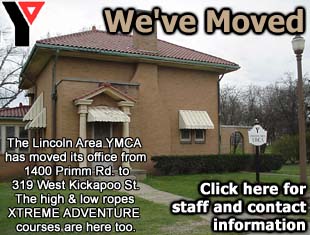|
The
current project, according to Dr. Jack Nutt, college president,
will almost complete the Lincoln College campus.
He envisions one more building program that will bring the
only two-year residential college in the state of Illinois to what
he considers its final phase.
“The
mission of Lincoln College is the concept of personal education,”
Nutt said. “We have
a full-time faculty member for every 13 students.
I see a residential population of 525 as best to serve our
students.” Currently
the college has a residential population of approximately 475
students. The number of non-residential students – those who
commute and those who live in the community – may vary, but the
number of residential students should stay at about 525, he said.

[Construction
workers put up the frame for the first floor of the new
three-story Lincoln College dormitory which will house 160
students.]
Construction
of the new dormitory, as yet unnamed, is underway behind Spatz
Hall and Forsythe dormitory, on the northwest side of Ottawa
Street. When
completed, the dormitory will have a total of 160 beds, as well as
offices for the school nurse, the dean of students and the
director of housing. The
dormitory will be in the shape of a U. Phase one, the current project, is the “long spine” of
the building, which will house 120 of the 160 rooms.
When
the spring semester ends, Spatz Hall will be taken down and
construction can begin on the south wing of the new dormitory,
which Nutt said would be completed by January.
Forsythe Hall, a dormitory 30 years old and “not very
efficient,” according to Nutt, will probably be taken down
during the second semester of next year, depending on the need for
housing. When
Forsythe comes down, construction will begin on the north wing, to
be completed by the fall of 2001. The other older dormitories,
Olin-Sang, Carroll Hall and Hoyle, are in good shape and, with
minor renovations, will stay as they are.
All
rooms in the new dormitory will be single rooms, with sinks in
each room and a stool and shower serving every two rooms.
This will give the college a total of 280 single dormitory
rooms. The
other 120 single rooms are in the Heritage dormitories, built in
1998 and 1999.
The
new single rooms are a response to the many students who want more
privacy than the old-style dormitory rooms offer, Nutt said.
The new dormitories also offer more privacy because there
are fewer students to a floor, he pointed out.
Students will now have a choice of three types of living
styles at different prices. Along
with the single rooms in the new dorms, they may choose double or
single rooms without private baths in the old dormitories.
|

The new classroom and office building will be located directly
behind University Hall, the only original building on campus and
the college landmark. According to plans, the
new building will have offices for 12 faculty members, including
the five coaches, as well as classrooms.
"The
new building will replace classrooms lost from Spatz Hall and also
allow us to take some of the pressure off University Hall,” Nutt
said. The landmark three-story building, constructed in 1865,
still has classrooms on the second floor but is not easily
accessible for the handicapped.
The
Johnston Center needs more space because of the growing number of
students in the fine arts programs, Nutt explained.
“When I first came here in 1982, we had eight or 10 kids
majoring in fine arts. Now
there are 50 or 60.”
The
two-story addition will add 5,000 square feet to the fine arts
building. The lower
floor will have two classrooms, a computer laboratory and offices.
The first floor will provide a large practice room, two
offices and storage, as well as public restrooms.
The new practice area will allow vocal and dance students
to rehearse at the same time as instrumental students, Nutt said.
The
Johnston Center addition, the new classroom and office building,
and phase one of the new dormitory are scheduled for completion by
August 15. Roger
Webster of Lincoln is the contractor for the Johnston Center
addition; Diversified Buildings of Morton is putting up the new
classroom-office building; and Illinois Construction of
Bloomington, which also built the Heritage North and West
dormitories in 1998 and 1999, is putting up the new dormitory.

[Excavation
has begun for the two-story addition to the Johnston Center, home
of the performing arts on the Lincoln College campus.
The addition will add 5,000 square feet to the existing
building.]
Recent
building programs on the campus in addition to the Heritage
dormitories include Dooley Hall, a new admissions building, a
10,000-square-foot maintenance building, and new soccer and
baseball fields.
[Editor’s
note: A story
about Dr. Nutt’s vision for the completion of the campus and its
importance to the city of Lincoln will appear on Tuesday, April
11.]
[Joan
Crabb]
|



